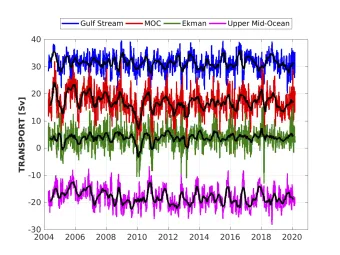
The Atlantic Meridional Overturning Circulation (AMOC) has been updated to March 2020 and is freely available to view online.
Observing and understanding the changes in the AMOC is critically important for identifying the mechanisms of decadal climate variability and change, and for interannual-to-decadal climate prediction. Sustained observations are also necessary for assessing the possibility of future abrupt change in the AMOC similar to those seen in palaeoclimate records.
The NOC-led RAPID-AMOC 26N project, which has been collecting data on the AMOC since 2004, in collaboration with the University of Miami and NOAA in the USA is key to this effort. An array of instruments cross the Atlantic from The Canary Islands to the Bahamas and measure temperature, salinity and current velocities from the near surface to the sea floor. The array data is combined with observations of the Florida current and satellite measurements of surface winds to calculate the overturning circulation.
Dr Ben Moat, Physical Oceanographer at the NOC and Co-Chief Scientist of the project, commented on the recent data release: “With every recovery of data from the RAPID 26N array of instruments, we learn new things about how the large-scale ocean changes on timescales of days to decades. These observations provide a unique dataset used to validate the numerical models used for weather and climate predictions.”
To view the new data please visit the RAPID dedicated website - https://rapid.ac.uk/rapidmoc